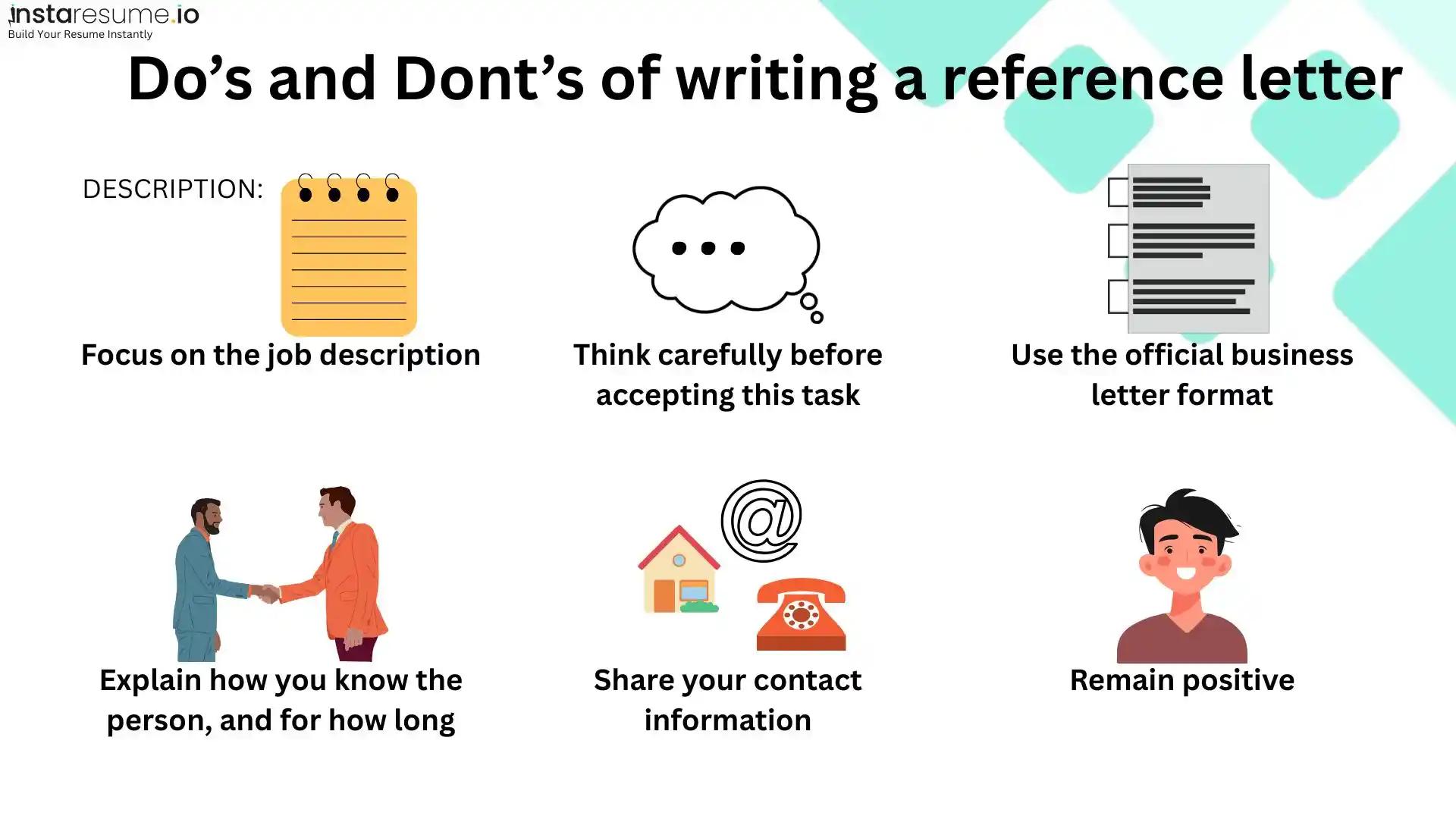10 do’s and don’ts of writing a reference letter
Trust Score: 4.8
353 reviews

Table of Contents
A reference letter might seem like a small formality, but in reality, it holds enormous weight in determining a person’s chances of landing a job, securing admission to a program, winning a scholarship, or even getting a visa. Unlike resumes, which are self-reported, or grades, which are numerical, a reference letter provides credibility by offering an external perspective. It captures not just what the candidate has achieved but also who they are as a professional, student, or individual.
The right letter is not simply a checklist of accomplishments. Instead, it should weave together stories, strengths, and real-life examples that allow the reader to see the candidate’s potential. A generic or half-hearted letter, on the other hand, can flatten an otherwise outstanding application.
This blog takes you through the 10 essential do’s and 10 common don’ts of writing a reference letter. Whether you are a professor, employer, mentor, or colleague asked to draft one, this guide will help you produce letters that are authentic, professional, and persuasive.
What is a reference letter and why it matters
A reference letter (sometimes called a recommendation letter, though the two differ slightly) is a written statement from a professional, academic, or personal contact that evaluates an individual’s qualifications, skills, character, and potential.
Why it matters
Builds trust and credibility – Institutions and employers value third-party assessments because they carry more objectivity than self-promotion.
Adds dimension beyond resumes – Numbers and bullet points on a CV show what a candidate did, but a reference letter demonstrates how they did it.
Differentiates candidates – In a competitive field, personal anecdotes and specific examples can make one candidate stand out from a sea of applicants.
Types of reference letters
Professional references: Written by supervisors, managers, or employers to highlight workplace achievements.
Academic references: Written by professors or teachers to emphasize intellectual skills, research ability, and academic performance.
Character/personal references: Written by mentors, community leaders, or peers to vouch for integrity, personality, and reliability.
Where they are needed
 Job applications
Job applications University or graduate school admissions
University or graduate school admissions Scholarships and fellowships
Scholarships and fellowships Immigration processes
Immigration processes Rental agreements or financial references
Rental agreements or financial references
A strong reference letter typically follows a three-part structure:
Introduction – explain who you are, how you know the candidate, and in what capacity.
Body – highlight achievements, strengths, and qualities using real-life examples.
Conclusion – provide a clear endorsement and include your contact details.
By following this structure and observing the do’s and don’ts outlined below, your letter can carry authority and significantly strengthen the candidate’s case.
10 do’s of writing a reference letter
1. Understand the purpose
Every reference letter serves a different goal. A hiring manager wants evidence of job performance, while a scholarship committee values academic excellence and social impact. Writing without tailoring the letter risks making it irrelevant.
Why it matters:
 Helps you highlight qualities the reader actually cares about.
Helps you highlight qualities the reader actually cares about. Prevents you from wasting space on unrelated traits.
Prevents you from wasting space on unrelated traits. Shows respect for the candidate’s application by customizing your effort.
Shows respect for the candidate’s application by customizing your effort.
Strong example:
“For the MBA program at XYZ University, I am pleased to recommend Arjun Mehta, whose leadership in student-run initiatives and analytical skills in finance courses make him an excellent fit.”
Weak example:
“Arjun is hardworking and friendly.” (Too vague, not aligned with MBA requirements.)
Template:
“I am writing to recommend [Candidate Name] for [purpose – job, program, or scholarship], focusing on [qualities/skills] because of [specific example].”
Pro tip: Always ask the candidate for the job description or program brochure. This ensures you hit the right keywords that selection committees are scanning for.
2. Use a professional format
A well-structured letter immediately sets the right tone. Presentation matters almost as much as content.
Why it matters:
 Recruiters often skim; a clear layout makes key points easy to spot.
Recruiters often skim; a clear layout makes key points easy to spot. A professional appearance boosts credibility.
A professional appearance boosts credibility. Proper formatting shows attention to detail, reflecting well on both you and the candidate.
Proper formatting shows attention to detail, reflecting well on both you and the candidate.
Strong structure:
 Letterhead or your contact information
Letterhead or your contact information Date
Date Recipient’s name and details
Recipient’s name and details Salutation
Salutation Introduction (who you are, how you know the candidate)
Introduction (who you are, how you know the candidate) Body (skills, examples, achievements)
Body (skills, examples, achievements) Conclusion (strong recommendation + contact info)
Conclusion (strong recommendation + contact info) Closing and signature
Closing and signature
Weak structure:
A single block of text with no greeting or closing.
Pro tip: Keep the letter to one page (300–500 words). Concise, structured letters are far more effective than long, rambling ones.
3. Be honest and accurate
Exaggeration is tempting but dangerous. If discovered, it hurts both you and the candidate.
Why it matters:
 Employers and admissions offices may verify details.
Employers and admissions offices may verify details. Honesty ensures the candidate is evaluated fairly.
Honesty ensures the candidate is evaluated fairly. A truthful letter reflects your integrity as a professional.
A truthful letter reflects your integrity as a professional.
Strong example:
“I supervised Priya Sharma as a project coordinator from 2021 to 2024. She successfully managed multiple cross-functional projects and consistently earned positive client feedback.”
Weak example:
“Priya is the best employee I have met in my 30-year career, perfect in every way.” (Unrealistic and undermines credibility.)
Pro tip: If you cannot honestly recommend someone, politely decline instead of writing a weak or dishonest letter.
4. Include specific achievements
A reference letter should highlight accomplishments, not just personality traits. Numbers and outcomes carry weight.
Why it matters:
 Shows measurable impact.
Shows measurable impact. Differentiates the candidate from generic “hardworking” applicants.
Differentiates the candidate from generic “hardworking” applicants. Makes your recommendation concrete and verifiable.
Makes your recommendation concrete and verifiable.
Strong example:
“Rohan increased regional sales by 22% within one year and introduced a client onboarding process that reduced drop-off by 15%.”
Weak example:
“Rohan is good at sales.”
Pro tip: Use the STAR method (Situation, Task, Action, Result) to describe achievements. This provides context and clarity.
5. Highlight relevant qualities
Candidates may have many positive traits, but not all are useful for the opportunity at hand. Pick those that align with the role or program.
Why it matters:
 Shows you understand the requirements.
Shows you understand the requirements. Reinforces the candidate’s fit for the position.
Reinforces the candidate’s fit for the position. Prevents wasting space on irrelevant details.
Prevents wasting space on irrelevant details.
Strong example:
“As a marketing associate, Ayesha combined creativity with data-driven insights, leading a social media campaign that boosted engagement by 40%.”
Weak example:
“Ayesha is neat, polite, and punctual.” (Positive but irrelevant for marketing.)
Pro tip: Scan the job posting or program requirements and mirror their language. If the ad emphasizes “problem-solving,” use that exact phrase.
6. Keep the tone positive and professional
Your letter should sound confident and supportive, without slipping into casual or overly emotional language.
Why it matters:
 A positive tone makes the candidate look stronger.
A positive tone makes the candidate look stronger. Professional language maintains credibility.
Professional language maintains credibility. Avoids raising red flags about hesitancy.
Avoids raising red flags about hesitancy.
Strong example:
“I had the pleasure of working with Karan for two years, during which he demonstrated initiative, leadership, and excellent communication skills.”
Weak example:
“Karan is a super cool guy and the life of the office.” (Too casual.)
Pro tip: Use strong, confident words: “consistently,” “excelled,” “demonstrated,” “reliably.” Avoid hesitant language like “might,” “probably,” or “seems.”
7. Provide your relationship with the candidate
Readers want to know how you are qualified to comment on the candidate.
Why it matters:
 Establishes context and credibility.
Establishes context and credibility. Shows the depth of your knowledge about the candidate.
Shows the depth of your knowledge about the candidate. Helps the reader trust your assessment.
Helps the reader trust your assessment.
Strong example:
“As Priya’s professor in the MBA program, I taught her in three courses, including Strategic Management, giving me ample opportunity to evaluate her skills.”
Weak example:
“I don’t know Priya very well, but she seems good.”
Pro tip: Always include capacity + timeframe + context. For example, “As her direct supervisor for two years at ABC Corp…”
8. Use clear and concise language
Simple language communicates better than jargon or wordy sentences.
Why it matters:
 Saves the reader’s time.
Saves the reader’s time. Prevents misinterpretation.
Prevents misinterpretation. Keeps the focus on the candidate’s strengths.
Keeps the focus on the candidate’s strengths.
Strong example:
“He manages difficult clients with calm professionalism.”
Weak example:
“He has a very good ability to handle clients in difficult circumstances and always tries to remain calm.”
Pro tip: After drafting, read your letter aloud. If a sentence feels long or confusing, shorten it.
9. Proofread carefully
Errors signal carelessness and reduce credibility.
Why it matters:
 Protects your professionalism.
Protects your professionalism. Prevents misunderstandings.
Prevents misunderstandings. Shows respect for the candidate.
Shows respect for the candidate.
Strong example:
“She has excellent communication skills.”
Weak example:
“She have excellent comunication skills.”
Pro tip: Proofread twice—once silently, once aloud. Use grammar tools if necessary. Always double-check the candidate’s name and dates.
10. End with a strong recommendation
A clear, confident conclusion reinforces the candidate’s strengths.
Why it matters:
 Leaves a lasting impression.
Leaves a lasting impression. Shows your full support.
Shows your full support. Encourages the reader to act favorably.
Encourages the reader to act favorably.
Strong example:
“I strongly recommend Raj for this position without hesitation. Please contact me if you need further details.”
Weak example:
“You can consider him if no one better applies.”
Pro tip: Use decisive closing phrases like:
 “I strongly recommend…”
“I strongly recommend…” “I wholeheartedly endorse…”
“I wholeheartedly endorse…” “I am confident he will excel…”
“I am confident he will excel…”
10 don’ts of writing a reference letter
1. Don’t exaggerate or lie
Exaggeration weakens your credibility. Employers and admissions committees often cross-check references, so unrealistic praise can backfire. If a candidate is described as flawless, the reader may assume the letter is insincere or fabricated.
Why it matters:
 Overstating achievements makes your recommendation less believable.
Overstating achievements makes your recommendation less believable. False claims risk damaging your own professional reputation if exposed.
False claims risk damaging your own professional reputation if exposed. A misleading letter can set up the candidate for failure in a role they are not prepared for.
A misleading letter can set up the candidate for failure in a role they are not prepared for.
Weak example:
“Ravi is the most talented employee I have ever seen in my 25 years of work. He never makes mistakes and is perfect in every way.”
Strong example:
“Ravi consistently met deadlines, exceeded sales targets by 10%, and mentored three junior staff members with professionalism and patience.”
Pro tip: Stick to facts you can verify. If you wouldn’t feel comfortable repeating the statement in person to a hiring manager, don’t write it.
2. Don’t be too vague
Generic praise adds little value. Saying someone is “good” or “nice” doesn’t help decision-makers understand why they stand out.
Why it matters:
 Vague comments are forgettable and don’t differentiate the candidate.
Vague comments are forgettable and don’t differentiate the candidate. Committees want concrete, measurable proof of performance.
Committees want concrete, measurable proof of performance.
Weak example:
“Priya is good at her job.”
Strong example:
“Priya developed a customer retention strategy that increased client satisfaction scores by 20% in six months.”
Pro tip: Always answer the silent question in the reader’s mind: How do you know this? Back up every claim with an example.
3. Don’t focus only on weaknesses
A reference letter should highlight strengths. Dwelling on flaws risks sabotaging the candidate’s chances. If you feel uncomfortable endorsing someone, it’s better to decline writing the letter.
Why it matters:
 Employers may interpret negativity as a warning sign.
Employers may interpret negativity as a warning sign. Overemphasis on flaws overshadows strengths.
Overemphasis on flaws overshadows strengths.
Weak example:
“Ankit sometimes struggled with deadlines, but he eventually got his work done.”
Strong example:
“Ankit quickly adapted to new project management tools, which helped him significantly improve his turnaround time.”
Pro tip: If you must mention a growth area, frame it constructively. Instead of “weaknesses,” show improvement and potential.
4. Don’t use unprofessional language
Your tone represents both you and the candidate. Casual language, slang, or jokes make the letter sound unserious.
Why it matters:
 Informality reduces credibility.
Informality reduces credibility. Professional tone demonstrates respect for the process.
Professional tone demonstrates respect for the process.
Weak example:
“Neha is a fun buddy to hang out with at work. She’s the life of the office.”
Strong example:
“Neha is a reliable colleague whose professionalism strengthens team collaboration and workplace culture.”
Pro tip: Imagine your letter being read by a hiring committee or university dean. If the tone would embarrass you in that setting, rewrite it.
5. Don’t be overly brief
A one-line reference letter suggests you don’t know the candidate well or don’t value their request. Brevity makes your endorsement weak and forgettable.
Why it matters:
 Too-short letters may raise doubts about the candidate’s credibility.
Too-short letters may raise doubts about the candidate’s credibility. Lack of detail makes it hard for decision-makers to evaluate suitability.
Lack of detail makes it hard for decision-makers to evaluate suitability.
Weak example:
“Rahul worked here. He did fine.”
Strong example:
“Rahul worked with our team for three years, contributing significantly to product development. His work on redesigning the backend reduced processing time by 15%.”
Pro tip: A strong reference letter should generally be one page (300–500 words). Anything shorter risks appearing careless.
6. Don’t include irrelevant details
Personal information like marital status, hobbies, or religion has no place in a professional reference letter unless explicitly requested.
Why it matters:
 Irrelevant details distract from the candidate’s qualifications.
Irrelevant details distract from the candidate’s qualifications. They may unintentionally introduce bias or discrimination.
They may unintentionally introduce bias or discrimination.
Weak example:
“Meena is married with two kids and loves baking.”
Strong example:
“Meena demonstrated excellent organizational skills, managing complex projects with precision and leadership.”
Pro tip: Focus only on skills, achievements, and qualities relevant to the opportunity. Leave out private details.
7. Don’t forget to proofread
Errors in grammar, spelling, or formatting reduce the professionalism of the letter and reflect poorly on both you and the candidate.
Why it matters:
 Typos suggest carelessness.
Typos suggest carelessness. Small mistakes can change meaning.
Small mistakes can change meaning. A polished letter demonstrates respect and attention to detail.
A polished letter demonstrates respect and attention to detail.
Weak example:
“He is a grate leeder with excelent comunicashun skills.”
Strong example:
“He is a great leader with excellent communication skills.”
Pro tip: Read your letter aloud, use grammar tools, and double-check names and dates. A simple typo in the candidate’s name can cost them the opportunity.
8. Don’t write without knowing the purpose
A generic letter has little impact. Tailor your recommendation to the specific role, program, or scholarship.
Why it matters:
 Purpose-driven letters sound more convincing.
Purpose-driven letters sound more convincing. Decision-makers look for alignment with their criteria.
Decision-makers look for alignment with their criteria.
Weak example:
“Arjun is good at many things.”
Strong example:
“Arjun’s expertise in financial analysis and his ability to lead cross-functional teams make him an ideal fit for the Finance Manager position.”
Pro tip: Always ask the candidate for context—resume, job description, or program details—before writing.
9. Don’t compare unfavorably to others
Comparisons often weaken your letter and create doubt. Your goal is to highlight what makes the candidate valuable, not rank them against peers.
Why it matters:
 Negative comparisons overshadow achievements.
Negative comparisons overshadow achievements. Recruiters may question why you didn’t focus on unique strengths.
Recruiters may question why you didn’t focus on unique strengths.
Weak example:
“Kavita isn’t as good as her teammates, but she tries hard.”
Strong example:
“Kavita consistently contributes creative solutions and brings innovative thinking to team projects.”
Pro tip: Replace comparisons with concrete contributions. Show how the candidate adds value on their own terms.
10. Don’t decline to recommend without explanation
A vague or lukewarm recommendation suggests hesitation, which hurts the candidate. If you cannot genuinely endorse someone, it’s better to decline writing altogether.
Why it matters:
 Neutral or unclear language signals doubt.
Neutral or unclear language signals doubt. Employers may interpret silence as a negative review.
Employers may interpret silence as a negative review.
Weak example:
“I cannot comment on Sandeep’s abilities.”
Strong example:
“I confidently recommend Sandeep, whose leadership and dedication made him an asset to our organization.”
Pro tip: Be decisive. If you support the candidate, say so clearly. If you can’t, politely decline to write the letter instead of weakening their chances.
Frequently asked questions about writing a reference letter
1. What is the difference between a reference letter and a recommendation letter?
Although people often use the terms interchangeably, there’s a subtle difference:
 A reference letter is generally more objective and descriptive. It outlines the candidate’s qualifications, skills, and character without necessarily urging action. For example, “Amit is diligent and completed his projects on time.”
A reference letter is generally more objective and descriptive. It outlines the candidate’s qualifications, skills, and character without necessarily urging action. For example, “Amit is diligent and completed his projects on time.” A recommendation letter, on the other hand, is more persuasive. It actively endorses the candidate for a specific opportunity, such as a job or program. For example, “I strongly recommend Amit for the position of Senior Analyst because of his proven record in data modeling.”
A recommendation letter, on the other hand, is more persuasive. It actively endorses the candidate for a specific opportunity, such as a job or program. For example, “I strongly recommend Amit for the position of Senior Analyst because of his proven record in data modeling.”
Why it matters: Employers and academic committees often look for recommendations rather than neutral references. A recommendation is stronger because it includes both facts and advocacy.
Pro tip: If asked for a “reference,” clarify whether a recommendation is more appropriate. In many cases, offering a strong recommendation letter gives the candidate a competitive edge.
2. How recent should the experience in the letter be?
Relevance is crucial. A reference letter should ideally describe experiences from the last 2–5 years. Outdated examples from a decade ago may no longer reflect the candidate’s current capabilities.
Example:
 Weak: “I supervised Priya during her internship in 2010.” (Outdated and irrelevant for a 2025 application.)
Weak: “I supervised Priya during her internship in 2010.” (Outdated and irrelevant for a 2025 application.) Strong: “I supervised Priya in her role as Project Manager from 2021 to 2024, where she led a team of 12.”
Strong: “I supervised Priya in her role as Project Manager from 2021 to 2024, where she led a team of 12.”
Why it matters: Employers and committees want to know what the candidate can do now, not what they did years ago.
Pro tip: If you only have older experience with the candidate, update it by mentioning how those skills have remained consistent or how you’ve seen them grow since.
3. Can I write in the first person?
Yes, first-person writing makes the letter sound authentic and personal. Phrases like “I have observed,” “I supervised,” or “I recommend” carry authority and responsibility.
Example:
 First-person: “I had the privilege of teaching Rohan in two advanced mathematics courses, and I observed his problem-solving ability firsthand.”
First-person: “I had the privilege of teaching Rohan in two advanced mathematics courses, and I observed his problem-solving ability firsthand.” Third-person: “Rohan was taught by his professor in advanced mathematics, who observed his problem-solving ability.” (Detached and awkward.)
Third-person: “Rohan was taught by his professor in advanced mathematics, who observed his problem-solving ability.” (Detached and awkward.)
Why it matters: Using first-person avoids sounding generic or automated, and it connects your credibility directly to the candidate’s performance.
Pro tip: Balance personal observation with professional tone. Avoid “I feel like he’s cool” and instead use “I strongly believe he is capable of excelling in this role.”
4. Should I use letterhead?
Yes. If you are writing on behalf of an organization, letterhead adds professionalism and authenticity. For academic or corporate recommendations, letterhead is often expected.
Why it matters:
 Proves the letter is genuine.
Proves the letter is genuine. Adds authority, especially if the organization is reputable.
Adds authority, especially if the organization is reputable. Helps distinguish your letter from casual personal notes.
Helps distinguish your letter from casual personal notes.
Pro tip: If you don’t have official letterhead (e.g., for personal references), include your full name, job title, organization, and contact details at the top. Formatting can make even a non-letterhead document look professional.
5. Is confidentiality important?
Yes, confidentiality can influence how seriously the letter is taken. Some institutions prefer sealed letters or direct submissions to ensure honesty. A candidate shouldn’t see the letter in those cases, as it may encourage more candid assessments.
Why it matters:
 Confidential letters are seen as more trustworthy.
Confidential letters are seen as more trustworthy. Shows you’re respecting institutional guidelines.
Shows you’re respecting institutional guidelines. Reduces the pressure of writing only positive comments.
Reduces the pressure of writing only positive comments.
Pro tip: Always check submission instructions. If the process requires uploading directly to a portal or mailing a sealed envelope, follow that exactly. Non-compliance can disqualify the letter.
6. Can peers write reference letters?
Yes, but with limitations. Letters from supervisors, professors, or senior colleagues carry more weight because they show authority. Peer letters can work for character references or when demonstrating teamwork and collaboration.
Example:
 Strong (peer in team setting): “As Rahul’s colleague for three years, I worked alongside him on multiple projects and can vouch for his dedication and technical expertise.”
Strong (peer in team setting): “As Rahul’s colleague for three years, I worked alongside him on multiple projects and can vouch for his dedication and technical expertise.” Weak (peer without context): “Rahul is my friend, and I think he’s hardworking.”
Weak (peer without context): “Rahul is my friend, and I think he’s hardworking.”
Pro tip: If you’re a peer writing a reference, emphasize collaboration, teamwork, and interpersonal skills rather than authority.
7. What if I am too busy to write a detailed letter?
If you cannot give the letter the attention it deserves, it’s better to decline politely. A rushed or generic letter can harm the candidate more than help.
Why it matters:
 A short, vague letter looks like a lack of confidence.
A short, vague letter looks like a lack of confidence. Employers may interpret it as disinterest.
Employers may interpret it as disinterest.
Pro tip: If you want to help but lack time, ask the candidate to provide a draft or bullet points. You can then refine and personalize it. This saves time while still ensuring quality.
8. Are digital letters valid?
Yes. In fact, digital submissions are now the norm. Most organizations accept PDFs or uploads directly through portals. E-signatures are also widely accepted.
Why it matters:
 Ensures quick delivery and easy verification.
Ensures quick delivery and easy verification. Saves time and avoids postal delays.
Saves time and avoids postal delays. Accepted as official if formatted properly.
Accepted as official if formatted properly.
Pro tip: Always save the letter as a PDF to preserve formatting. Avoid sending editable Word documents, as they can be altered.
9. How early should a candidate ask for a letter?
The earlier, the better. Ideally, candidates should ask at least 2–3 weeks before the deadline. This allows you to plan, draft, and proofread the letter properly.
Why it matters:
 Prevents rushed writing.
Prevents rushed writing. Gives time to clarify requirements.
Gives time to clarify requirements. Shows respect for your schedule.
Shows respect for your schedule.
Pro tip for candidates: Provide your referee with your resume, the job description, or program details to make the writing process smoother.
10. Does formatting matter?
Absolutely. A poorly formatted letter looks unprofessional, even if the content is strong. Presentation can influence how seriously the letter is taken.
Best practices:
 Use a professional font (Times New Roman, Calibri, or Arial, size 11–12).
Use a professional font (Times New Roman, Calibri, or Arial, size 11–12). Maintain clear paragraphs with proper spacing.
Maintain clear paragraphs with proper spacing. Align text neatly, keep margins consistent.
Align text neatly, keep margins consistent. Stick to one page unless otherwise specified.
Stick to one page unless otherwise specified.
Pro tip: If you’re submitting digitally, preview the PDF to ensure formatting doesn’t break. Small errors like misaligned margins can make a letter look sloppy.
Conclusion
A reference letter is far more than just a favor or a formality—it is a professional endorsement that can influence someone’s career, education, or life opportunities. Done correctly, it not only strengthens the candidate’s case but also reflects positively on you as the writer.
The do’s—such as being honest, tailoring to the purpose, including achievements, and proofreading—help you craft a letter that is both persuasive and professional. The don’ts—such as exaggeration, vagueness, unprofessional tone, or irrelevant details—help you avoid mistakes that could unintentionally harm the candidate.
When combined with clarity, specificity, and professionalism, your reference letter becomes a powerful tool that can open doors. Remember: behind every letter is a person placing their trust in you. Writing thoughtfully and responsibly is not just a task—it’s a contribution to someone’s future success.






